
| Back to Ben Goertzel's Research Papers and Essays |
Time is a mystery, perhaps the ultimate mystery. It is deeply wrapped up with the mind/body problem and the mystery of consciousness. Yet only very infrequently do we scientists take time out to reflect upon the nature of time.
The concept of dynamics, as pursued in the articles in this book and elsewhere, relies fundamentally on the notion of time. Time, it is assumed, flows in one direction, leading to a series of events that occur one after the other. This is the conventional view, in both science and philosophy.
It is not clear, however, that this convenient, conventional view of time is in entirely accurate. There are good reasons to take a view of time as something helical rather than linear. In this article I will outline the helical view of time, from the perspective of both physics and phenomenology.
We will look at the nature of time here from two angles: physics and phenomenology. This may seem an odd juxtaposition, but it turns out to be entirely appropriate. In the context of time, as in so many other contexts, physics provides a very concrete way of thinking about the exact same issues that arise in other, nonphysical points of view. The relationship between the world of physics and the world of psychological experience is close, subtle, and not at all accidental.
Ultimately, I believe, all of dynamical systems theory -- and for that matter all of science -- may have to be re-thought in terms of helical time. For now, though, these ideas are simply presented here to stimulate the reader's mind. They present yet another angle on the self-organizing, complex evolution of systems in the universe. They also present an interesting counterpoint to Mark Germine's article, immediately preceding this one, which treats the subtle interconnections between the arrow of time and the evolution of the ego. Germine's vision of time and my own are complementary and interrelated, and surely both represent part of the ultimate truth.
It is well known that none of the basic equations of physics include an arrow of time. In classical physics, in quantum theory, in relativity theory -- the equations run just as well forwards as backwards. They recognize a linear model of time, but it is a line that looks like this:


This time-reversibility of our physical equations is not a mathematical fluke; it is a scientific fact that reflects a deep philosophical truth. It reflects the truth that unidirectional time is not fundamental. Unidirectional time is here, but it emerges from a more fundamental substrate of bidirectional (or perhaps even multidirectional) time.
This process of the "emergence of time's arrow" is envisioned most clearly in the branch of classical physics known as thermodynamics (the study of heat). Here the arrow of time is understood as a statistical phenomenon (see Prigogine and Stengers, 1997; Goertzel, 1997). The uni- directional arrow of time is seen to emerge when a large number of particles are taken together, as a group.
The key notion here is the Second Law of Thermodynamics, which talks about a quantity called entropy The Second Law says that entropy can never decrease. This is quite different in nature from the First Law of Thermodynamics, the conservation of energy, which states that the amount of energy in a closed system must always remain the same. Conservation of energy gives us no way to measure time: the energy of a closed system is the same now as it was yesterday, and the same as it will be tomorrow. The non-decrease of entropy, on the other hand, gives us a way of telling which of two states of a closed system comes first. If state A has a lower entropy than state B, then state A must be temporally prior.
In fact, few physicists worry about this, but the Second Law of Thermodynamics presents a bit of a mathematical paradox. The details of this paradox are fairly involved , but the concept can be communicated geometrically. Suppose the state of a system is represented by a region in space:
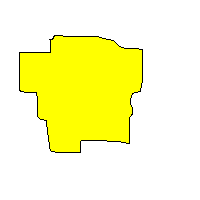
What gives? What happens is that comes to the rescue. Chaotic dynamics means that the region representing the state of the system becomes more and more diffuse and intricate, over time:
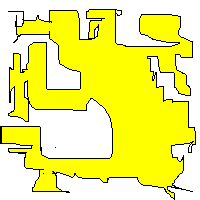
In short, the region becomes The result of this is that, while the area is conserved, the computation of the area by actual observers becomes increasingly difficult. The tiny little branching fingers of the fractal become too fine for any eye to see. Ultimately, each observer has to "coarse grain" the picture in order to estimate the area -- which results in an overestimate of the area of the region. And this is how entropy comes about: the region describing the system becomes so diffuse and complicated that it fools any observer into believing its area is larger than it is.
In other words, as it turns out, entropy increase is in the eye of the beholder! The occurence of entropy increase is a consequence of the fact that the physical world is known only by observers with imperfect measuring instruments. To a non-physical god, who could measure everything with infinite precision, there would be no entropy, and the arrow of time would be two-pointed.
When we move beyond classical thermodynamics to the world of quantum physics, we find things yet stranger. The equations of quantum physics, like those of classical physics, are fundamentally reversible: they do not give a particular direction to the arrow of time. But here one finds that, in fact, the assumption of a particular direction for time confuses and complicates things . The interpretation of quantum physics becomes much simpler if one assumes that time goes both forwards and backwards!
Cramer (1988) has proposed that every entity in the universe (every particle) sends out waves both forwards and backwards in time. Observed events occur when a forward wave collides with an appropriate backward wave. This may seem peculiar, but in fact it is completely consistent with everything that is known about the physical universe. The numerous paradoxes of quantum reality all disappear when one drops the assumption that events occur at particular points in time
Just as in thermodynamics, however, the symmetry of past and future is ruined by the introduction of an observer. In quantum physics, it is the observation of a phenomenon that makes the phenomenon definite rather than merely probabilistic. Observing a phenomenon makes it "collapse" from an array of equally real possibilities to one real event and an array of other "didn't-happens." This is not changed by Cramer's timeless interpretation of the theory: the only difference in his theory is that the collapse from uncertainty to certainty is something that comes about, at a particular moment, as a consequence of the microscopic state of the universe at all past and future times.
A slightly different way of phrasing this is given by the Many-Worlds Interpretation of quantum physics, according to which an observation represents, not a collapse of uncertainty to certainty, but rather a partitioning of the space of possible universes: into some universes where the measurement came out this way, some universes where the measurement came out that way, some universe where the measurement came out yet another way, etc.... In this interpretation, one says that the dynamics of the multiverse are perfectly well reversible -- it is only by trying to partition the multiverse up into pieces that we create irreversibility. The flow of time is created by an arbitrary partitioning of the multiverse/universe into pieces.
The upshot is that, on the microscopic level, there just plain is no direction to time -- and this is even more spectacularly true in quantum physics than in classical physics. In the microscopic domain, everything just exists in a kind of nebulous, atemporal continuum. Then, every once in a while, something becomes observable, and enters the one-dimensional time continuum. The arrow of time does not exist in the universe as a whole. It only exists in individual subjective views of the universe!
Finally, when one moves beyond fundamental physics to the domain of cosmology -- the question of the birth of the universe -- things become even slipperier. For a while cosmologists thought about the Big Bang as the moment at which time began. There was no time, and then -- BANG! -- time came into existence. But now a subtly different interpretation has emerged (Hawking, 1993; Smith, 1997). Perhaps there was no time, not only at the moment of the Big Bang, but in the very early universe, for a "little while" after the Big Bang (it is not clear what a "while" means in this context!). Perhaps time came to emerge only gradually, as the universe got larger and larger, and cooler and cooler. After all, at the microscopic level, time still doesn't exist! An elementary particle today is still "at one" with the particles that existed at the very beginning of the universe, bound together by quantum nonlocality.
The details of temporal structure vary from one branch of physics to another. The key point I want to make, however, holds true whether one is talking quantum theory, thermodynamics or cosmology: it is the extent to which the model of time as an arrow pointing in one direction has been abandoned by modern physical theory. The one direction of time is now viewed as an approximation to the true nature of the universe -- an approximation induced by the perceptual limitations of particular observers like us. If we could see the way things really are, says modern physics, we would see time running two directions at once!
One way to summarize these conclusions is to introduce what I call a helical model of time. Helical time is time which moves around and around in circles, occasionally, however, moving somewhere that it has not gone before, going off in a new direction. It is backwards- forward- moving time, without the backwards and forwards necessarily being in equal balance.
The concept of helical time gives us a vision of a time that is moving linearly in one direction -- but only probabilistically so. Instead of moving forwards 100% of the "time," it is moving forwards perhaps 60% of the time, and backwards 40%. Or maybe it is moving forwards 80% of the time, and backwards 20%.
The word "helical" is used here metaphorically; I am not talking about a precise mathematical helix structure. If one wishes to visualize time as a helix, however, some care should be taken. One should not envision a helix wrapped neatly around an emergent linear time axis, like a vine around a pole. A better image is a helix that is angled with respect to the emergent linear time axis -- sometimes going forwards with respect to this axis, sometimes going back.
And it should be remembered that the helix of time does not grow around the emergent axis of time like a vine around a pole, either. Rather, the emergent axis of time is a kind of coarse-grained, averaged view of the motion of the helix of time. The linear flow of time is obtained from the underlying helical flow by the imposition of subjective ignorance.

It should be noted that the notion of time as a helix has been proposed before -- by Terrence and Dennis McKenna, in their visionary book The Invisible Landscape (1994). This book is visionary in the strict sense: it reports the contents of a vision, seen by the two authors while under the influence of hallucinogenic drugs obtained from Amazonian shamen. Part of this vision is that time is helical rather than linear. Another part is that time is moving toward a definite end, which the authors postulate to be the year 2012 (what they expect to happen in the year 2012 is not at all clear). Like mine, their helix is not a precise mathematical helix, but rather a fractal structure. I do not wish to ally my model of time with the McKennas': mine is relatively conservative, based on a synthesis of ideas from science and phenomenology, whereas theirs is a personal vision. But the connection is worth noting. My conjecture is that, in the course of their psychedelic explorations, the archetype of helical time presented itself to their minds, and then elaborated itself in a special way conditioned by their particular beliefs and ideas.
Moving ahead with physics, let us first think about helical time in the context of thermodynamics. Helical time helps us to make sense of the philosophically peculiar notion of an emergent arrow of time.
For it must be admitted that the notion of an emergent arrow of time is highly problematic, from a conceptual point of view. It is reasonable mathematically, and makes sense of what is observed in the lab -- but when one tries to get at the real essence of the idea, one is invariably stymied. After all, we do not typically think of time as something that exists in a statistical sense. Are we supposed to imagine that time's arrow suddenly emerges when one has precisely, say, seven million and forty-six particles? That would be preposterous. But what is the alternative? The mathematics ensures that time's arrow emerges when one has an infinite collection of particles -- but one never has an infinite collection of particles.
This paradox is avoided, however, if one envisions the arrow of time as something that arises gradually, bit by bit, as more and more particles are added to a system. But this kind of "gradual" view of the arrow of time is precisely a helical view. One views time as going in both directions, backward and forwards, but with a bias in one direction called "forwards." The bias is larger for more "macroscopic" systems, and basically nonexistent for truly "microscopic" systems.
The bias, however, is not intrinsic to macroscopic systems. It is, rather, induced by the errors necessarily introduced when an observer studies a macroscopic system. These errors involve a "coarse-graining" of the details of system dynamics, and a consequent blurring of physical reality -- a loss of information, an increase in entropy.
Thermodynamics speaks of the error involved in studying a macroscopic system, which necessitates the introduction of a helical view of time. Quantum theory, on the other hand, speaks of the uncertainty involved in studying microscopic systems -- an uncertainty which also necessitates the introduction of a helical view of time. To see this, in a detailed way, we must probe a little deeper into the nature of quantum measurement.
We have discussed the role of quantum measurement in causing the irreversible collapse of uncertain phenomena into definite phenomena. But what, in the end, is a "quantum measurement"? When does the quantum phenomenon become definite -- when it is registered on the dial of an instrument, or the screen of a laboratory computer? When it is recorded in the consciousness of an observing scientist? This question arises whether one believes the Many-Worlds interpretation, the Cramer forwards- and-backwards-waves theory, or any of the other interpretations of the quantum equations.
None of the interpretations of quantum theory really confronts this question of when the measurement occurs -- and, strictly speaking, they don't have to, because the formalism of quantum physics says that it doesn't matter where one draws the line and says a measurement has occured. Whether one says the measurement occurs when the dial on the instrument moves, when the data is displayed on the computer screen, or when certain neurons in the scientist's brain fire -- the ultimate numbers will come out the same.
The standard interpretation of quantum theory, the so-called Copenhagen Interpretation, does the best in this regard: it states that a quantum measurement arises from the interaction of some quantum phenomenon with some macroscopic measuring device. This rule of thumb works very well in the lab, in practical situations. But it begs the question: what, then, is "macroscopic"? And this question returns us to what I have called the statistical interpretation of quantum measurement.
Ideally, in order to say that a quantum phenomenon has been measured, we would like to say that its properties have been correlated with the properties of an infinite number of other particles. This would provide a good, solid definition of measurement. An infinite measuring device is definitely macroscopic! However, infinite measuring devices have the disadvantage that they do not exist. Instead, what we have are very large measuring devices.
Infinite measuring devices give definite measurements, that
result in a collapse from probability to definiteness, and
introduce an arrow of time into quantum dynamics. But what,
then, do very large measuring devices do? The only reasonable
answer is that they introduce a probabilistic arrow of time:
an arrow of time that has a certain chance of moving in
the "forward" direction, but also a certain chance of moving
backwards. The statistics of quantum measurement, in the end,
leads us to the same conclusion as the statistics of
thermodynamics. Probabilistic, helical time is real physical time. In the finite
physical world, unidirectional linear time is an idealization.
Now let us turn from physics to phenomenology. The topic at issue here is time as it presents itself to the experiencing mind.
What is the structure of this experienced entity, "time"? Is it a linear flow, from past through present to future? Is it a circle, forever zooming around and around? Is it something else entirely, something the thinking mind can never understand?
In the foregoing, I have presented arguments that the linear flow of "time's arrow" is only a statistical approximation to the true nature of physical reality. At the deepest level, in physical reality, time is reversible. It is only the introduction of individual, subjective measurement that induces the "illusion" of time's arrow. Physical time is best viewed as helical, as something that constantly wavers backwards and forwards, proceeding onward toward the future only in an uncertain, vacillating and oscillating manner.
But what about time as it is actually experienced -- what about the "stream of consciousness," the flow of events through the mind? Is this not a linear flow, a movement from past through present to future? What could be clearer?
A lot of things could be clearer, I believe. Here we are treading into the murky waters of phenomenology -- the description of individual, subjective experience. But this is a territory that it is deeply necessary to explore, in spite of the difficulties. Time is so basic to our experience -- almost more basic than "experience" itself -- that many readers are apt to feel that my words and concepts do not do justice to their subjective experience of time. No doubt my words and concepts do not -- for that matter, they do not even do justice to my own experience of time! But there is no use in getting hung up on the limitations of verbal and conceptual communication: we accept these limitations when we choose to speak, or listen, or read or write, whether about phenomenology or particle physics or pizza steaks.
The first phenomenological observation I want to make is that, inside any given moment, time is not going anywhere. Many thinkers have expressed this by positing a circular structure for time:
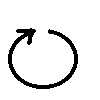
Time is, obviously, not always perceived as a circle. Time is indeed sometimes perceived as a moving-ahead, an arrow, a kind of abstract directed line. In our experience, we move back and forth between moments that are stationary and sufficient unto themselves, and moments in which phenomena rush past us, moving from present into future. Both Being and Becoming are crucial aspects of our awareness. The interesting thing is how these two aspects of temporal experience are made to harmoniously coexist. A great deal of the structure of mind, it turns out, can be understood as an adaptation to the presence of these two different experiences of time.
In order to explore the relation between circular and linear temporal experience, I will introduce a very simple model of consciousness that I call the box model. This model is inspired by the author's personal communications with Lou Kauffmann, a mathematician and philosopher whose work was, in turn, inspired by G. Spencer-Brown's classic book Laws of Form (1994). Many of the figures to be presented below also occur in Kauffmann's writings, e.g in his unpublished essay Sign and Space.
The box model may seem in first like it is pulled out of thin air. In fact, it can be grounded in system-theoretic psychology in a very deep and natural. Once the basic principles are laid out, I will elucidate some of its connections to underlying mental dynamics, and develop the model in a more psychological direction. For starters, however, it is best to consider the model in its own ultimate simplicity, without introducing extra information to complicate the matter.
Let us begin with an object, called Object, contained in consciousness. We will denote this by drawing a box around the object. Consciousness is the box. The meaning and justification of the "box" metaphor for consciousness will be taken up later; for now let us just adopt it as a working hypothesis, and see where it leads.
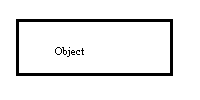
First of all, I will use the box model of consciousness to explore the old aphorism, which states that:
I believe that in fact this aphorism is not a sophism, but a deep observation, with profound relevance to the linear and circular models of time. To illustrate this, I will explain the aphorism in terms of a family of dynamical iterations. These iterations will lead us into a detailed model of temporal experience, encompassing both linear and circular time, and connecting both to the underlying structure of the mind.
Consider, towards this end, some entity -- any entity, let's name it Object. Suppose our Object is entering Consciousness. Then, right away, we have an iterative process, which may be defined as follows:
Object
Consciousness of Object
Consciousness of Consciousness of Object
Consciousness of Consciousness of Consciousness of Object
...
This iteration reflects the essential action of consciousness: the way consciousness turns on itself, and makes itself its own subject. In the box model, it may be depicted graphically as follows:
1.

2.

3.
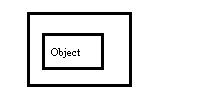
X = Consciousness of Consciousness of Consciousness of Consciousness...
or alternately
X = Consciousness of X
Pictorially, this "infinite limit" would appear as a fractal, the form of which is suggested in the following picture:
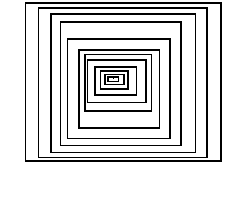
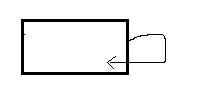
This may seem complicated enough, but it is actually a bare-bones consciousness iteration: each step is aware of only the step that came just before it. A full-on, ultra-deluxe consciousness iteration would be as follows:
Object
Consciousness of Object
Consciousness of {Object, and Consciousness of Object}
Consciousness of {Object, and Consciousness of Object, and {Consciousness of {Object, and Consciousness of Object}}
...
This represents a completely self-aware stream of consciousness, that culminates in an infinite form that Kauffmann calls the "Fibonacci Form," which can be described as
X = Consciousness of {X, and Consciousness of X}
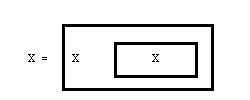
For those who like numerology, it may be interesting
to compute the number of occurences of "Consciousness" in the
n'th iterate of this process. Call this number Con[n]. Then
the ratio of Con[n+1] to Con[n] -- the "growth rate" of the
iteration, in Kauffmann's language -- comes out to precisely
the golden ratio,
The circular and linear views of psychological time both come straight out of this iterative process, this "consciousness iteration" that we have illustrated by drawing boxes within boxes. The linear view is there in the initial iteration, which was enumerated {1,2,3,...} just like the ticking of a clock. The circular view, on the other hand, is there in the infinite limit of the process, which embodies the realization that after each step, the iterative process just returns to itself. Suppose that, instead of starting with some Object, one actually starts with an infinite form, as obtained by the limits of these consciousness iterations. Then, one can expand the consciousness iteration, just as before, but things get a bit trickier! It turns out that the iteration does not change anything.
Suppose, for example, that one begins with an Object called X
defined by
X
X
X
...
The iteration, instead of tracing out an irreversible path through time, is stuck in a fixed point -- a timeless situation.

What happens when one begins one's hierarchy of reflexions with an infinitely reflexive form is that layer after layer of reflexion is constructed -- consciousness, consciousness of consciousness, and so on -- but it all, in the end, collapses to the same thing, consciousness itself! This is circular time! One goes around and around, iterating and iterating but staying in the same place. This is a mathematical model of the experience of consciousness turning back on itself, of living inside the one moment.
The story of our moment-by-moment experience, as will be elaborated shortly, is one of the combination of circular time with linear time. It is a story of repeated unfoldings of consciousness into a linear series, followed by collapses back to the beginning through infinite reflexion.
Incidentally, these "forms of consciousness" may seem an odd sort of mathematical construction, but it should be emphasized that they are perfectly legitimate, well-formed mathematical entities, if properly grounded in abstract set theory. The reader who is interested in such things may refer to the discussion of hypersets in (Goertzel, 1994).
These infinite "forms of consciousness" are unusual from the point of view of science. When approached from the perspective of spiritual wisdom, however, they come to seem perfectly normal. In order to see this, it suffices to make a slight change of terminology.
I am well aware of the dangers of taking up the sticky subject of the phenomenology of "enlightenment." But it is too tempting to pass up. For the consciousness iteration, as I have outlined it above, leads us directly to the conclusion that individuals in the enlightened state of consciousness do not experience the unidirectional flow of time. This conclusion -- that the truly spiritually advanced can step outside the order of time -- is a key axiom of many wisdom traditions, and it is quite exciting to see this conclusion emerge from simple mathematical considerations.
This detailed mathematical discussion of the subject of enlightenment may strike some readers as a bunch of absurd mumbo-jumbo. However, the fact is that, among those human beings who have taken the time to explore the varieties of spiritual experience, there is a striking agreement as to the "topology" of the territory found. There are differences in the details of different peoples' experience, but there are also broad areas of agreement. One of these is that the experience of Void, of pure absence which at once encompasses and annihilates everything else, is not "mumbo-jumbo." Another is that individuals who place themselves in a position of true and continual intimacy with the Void, will experience the universe in a way that transcends the linear structure of time as ordinarily experienced. These experiential facts are a significant part of human psychology, and in many human societies, they have been a crucial part of culture as well. A rich discussion of the relations between modern science and mathematics and wisdom traditions, elaborating on these points in a different way, may be found in (Combs, 1996).
Without further ado, then, let's get started. The crucial point here is
that we have, as an explicit or implicit
axiom in many wisdom traditions
(e.g. Zen
Buddhism), the idea that
The
generalized rule
The upshot of these "formulas" involving the Void is that the Void is quite simply an infinite limit of the consciousness iteration. More precisely, we might define the Void as the class of all infinite limits of consciousness iterations. Mathematically speaking, the two consciousness iterations we have considered have different solutions -- both infinite forms, but different. And other, slightly different consciousness iterations might have yet different solutions. But Void, as considered in wisdom traditions, solves all of these reflexive consciousness equations.
The point is that the dynamics of the enlightened mind, as an ideal form, is well described by the consciousness iteration with an infinite form Void as the starting point. For instance, to be explicit, one might have a series of states of consciousness as follows:
Void
Consciousness of {Void, and Consciousness}
Consciousness of {Void, and Consciousness of {Void, and Consciousness}}
...
or in other words
Void
Void
Void
...
There is no arrow of time here! Just the same thing, over and over again: nothing to show what comes after what. Furthermore, suppose that instead of beginning with "Void" alone, we begin with "Void and Object" -- meaning, a mental condition in which an Object and the Void are held as simultaneously present, without either one absorbing the other. Then, by the same rules, one arrives at the same conclusion: a linear sequence of "Voids" -- which, because of its eternally repetitive nature, does not describe an arrow of time at all. The conclusion is quite clear: in the enlightened state of consciousness, there is no direction to time.
Now let us return from the heights of enlightenment to ordinary human consciousness. It is time to get a little more explicit about what these boxes mean. Consciousness is not really a box -- what are the details underlying the metaphor?
Kauffmann, inspired by Spencer-Brown, takes the drawing of a box to indicate a "fundamental act of distinction." Distinguishing one thing from another -- inside from outside -- is, in this view, the most basic thing one can do. From this perspective it is silly to justify the very simple box model of consciousness in terms of more complex ideas involving the human mind and brain.
However, while I respect this perspective, I believe that the flow of ideas can go both ways. After introducing some ideas regarding the concrete psychological underpinnings of the box model, I will then propose some extensions to the box model, inspired by these psychological ideas. These extensions are, I believe, what is necessary in order to turn the box model of consciousness into a good model of psychological time.
In my chapters on consciousness, above, I proposed a model of consciousness called the Perceptual- Cognitive Loop. The idea of the Perceptual-Cognitive Loop, in brief, is that consciousness involves circuits joining the perceptual areas of the mind/brain and the cognitive areas of the mind/brain. The purpose of these circuits is to create coherent wholes: to take disparate collections of sense-stimuli and form coherent percepts; or to take disparate ideas or fragments of ideas and fuse them into coherent concepts. In essence, what this means is that consciousness makes things real: it makes them solid and substantial rather than fluctuating and ill-defined.
This perspective on consciousness agrees with all known data from cognitive and perceptual psychology and neurobiology. It is simple, and not tremendously informative, but it provides a good starting-point for further investigation.
The key point for the moment is: what does it mean to make a collection of mental entities coherent. What it means is to "beef the collection up," so that all the parts will stay linked together. The mind is continually self-organizing -- modifying and moving things around, for various reasons. What consciousness does, in the Perceptual-Cognitive Loop model, is to draw a sort of boundary around a collection of mental entities, protecting it temporarily from the interconnecting and disrupting processes of the mind. This is why consciously experienced entities are so much clearer than unconscious entities. Elements of the unconscious are constantly being disturbed and processed, combined with other things. Consciousness protects, by making various modifications to the structure and dynamics of the collections of entities that it processes.
It is, then, this protective and coherentizing function of consciousness that is symbolized by saying that consciousness "draws a box" around something. Of course, this box-drawing function of consciousness is not really an all-or-nothing phenomenon: to make a better metaphor, one might draw boxes of varying thickness, representing differing degrees of permeability. Mathematically, this leads to the concept of a fuzzy Laws of Form
It is also worth noting that the details of the process of box-building are different for different individuals. In particular, the concept of boundary thickness has been identified by Ernest Hartmann (1988) as being of importance in personality psychology. Some people habitually draw thicker "boundaries" around themselves than others, resulting in a greater subjective distinction between themselves and others, and a more "solid," less easily malleable mental state. Engineers and business people are likely to be thick-boundaries; artists and writers are likely to be thin-boundaried. Thin-boundaried people are more spiritual, which ties in with the notion that they tend more toward the circular experience of consciousness, rather than the linear experience. These variations give different people different flavors of experience, but do not alter the fundamental nature of experience.
Finally, before returning to the study of temporal experience, I must introduce the somewhat fanciful-sounding notion of an "antibox." The drawing of a "box" around a certain chunk of experience is, I have said, merely a metaphor for the protection of some set of mental processes from outside influence. A thicker box represents a more draconian collection of protective devices. An anti-box, then, is a collection of processes that undoes the protective devices erected by another set of processes.
The logic of "protective systems" in the mind is fairly intricate, and bears close resemblance to the logic of immune systems in organisms But the basic idea is simple: a system of mental processes protects itself by ensuring that it is very self-sufficient, that even if it is somehow "damaged" by external processes, it will be able to regenerate itself. Protection in this manner enables survival in difficult environments, but it can hamper fluidity and flexibility, and thus the mind requires methods of de-coherentizing as well as coherentizing.
Dreams, it can be argued, are one way in which the mind erects "antiboxes" around particularly self-protective thought-systems. In a formal neural network model, where memories are stored by the addition of vectors to a weight matrix, dreams can be represented by subtraction of vectors from the same weight matrix .
But dreams are not the only way of doing this. There are also daydreams, random musings, passing fantasies and whimsical thoughts. The mind has countless ways of undoing the formal boundaries that it erects within itself. The details of these strategies are not necessary here, as we are performing a very formal, abstract kind of modelling. But it is important to recognize that these abstract phenomenological considerations are grounded in very concrete psychological and even biological models. All the different views of the mind come together -- none is sufficient unto itself, and none can be omitted.
Now let us return to the box model of consciousness -- enhanced by boxes that can vary in thickness, and by anti-boxes (which might be viewed as boxes of negative thickness).
What is interesting about everyday human consciousness, I have said above, is the way we move back and forth between the two modes of consciousness -- between linear consciousness, represented by the initial stages of the consciousness iteration, and circular consciousness, represented by the infinite limit of the consciousness iteration. The box model of consciousness can be used to explore this phenomenon in detail.
First of all, let us enunciate a certain ground state for
consciousness: a self-
referential entity, an infinitely nested series of reflexions,
such as (for simplicity)

The "ground state" of circular time can be included in other states of consciousness -- e.g. enclosed in a box. Or it can encounter something else internally, draw it into its own sphere of awareness: this is indicated by drawing something else inside the self-referring box. In short, the self-referential ground state can be manipulated just like the ordinary boxes we have already been drawing.
How does this fundamental ground of circular time give rise to the "epiphenomenon" of linear time -- on a psychological level? What is required for the emergence of linear time, I will show, is merely the distinction and reification of some stage of consciousness as a definite, fixed thing. Once one reifies a particular moment of consciousness, that moment of consciousness can no longer be entered into and "collapsed" together with other moments of consciousness.
To understand this process better, let us suppose that we have two kinds of boxes representing consciousness. First there is the ordinary kind of box we have been drawing so far, and then there is a box with thicker lines, representing a reified moment of consciousness, a less "permeable membrane." The use of two kinds of boxes is, of course, still an oversimplification, just like the use of one kind of box. But it is an oversimplification which suits the present purpose.
When the self-referential ground state (X = Consciousness of X) encounters a thin box -- either on the inside or the outside -- it collapses it, entering into the realization that consciousness of consciousness is in fact just consciousness. Thus, for instance, one has


What seems to happen in conscious experience is that thick boxes are drawn, and then eventually disappear. But how do they disappear -- how does the self-referential ground state resume control?
One possibility is that the thickness of boxes decreases over time, until the thick boxes are absorbed along with all the other thin boxes, all the other moments. This is a real phenomenon -- mental entities do fade -- but it is not the whole story.
But another possibility is unveiled when we allow antiboxes to enter the picture. Antiboxes reflect the fact that it is also possible for the drawing of a box to be undone -- for consciousness to take a step back from reifying something, saying to itself "Wait a minute! Let's go back to where we were before that thought came up." This is an absolutely crucial point.
Formally, one can visualize this capacity in several ways, the simplest of which is to draw "antiboxes," which annihilate existing boxes, in a different color. In the following figure I indicate an antibox with a red line:

The antibox should be considered to annihilate the thick box rather than the things inside the thick box. It is destroying the protective processes of a thought system, and not the whole thought system itself. Thus, one may write also
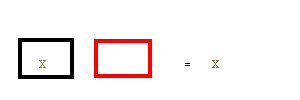
Our conscious experience, one might say, consists of a continual laying down of thick and thin boxes and antiboxes on the ground of reflexive self-consciousness. In this way we continually oscillate between consciousness that recognizes its own reflexive nature and curls back in on itself, and consciousness that objectifies itself and builds up a linear series. For a while the thick boxes build up and we have a linear stream of consciousness. And then the thick lines are all annihilated, and we have instead a smoothly flowing infinite circular stream of consciousness, flowing into itself again and again and again.
A state of consciousness containing only boxes within boxes within boxes is an entirely insular, perhaps "meditative" state. It makes no reference to sense percepts. However, we have already seen how to represent external objects of perception in this formalism. So far we have dealt with one object, called Object; but it is easy enough to denote a variety of different objects, say by different letters of the alphabet. The following denotes a complex state of consciousness involving a reflexive consciousness ground-state that is aware of the entity D, and also aware of a "coherentized" state of consciousness consisting of a system enclosed by a thick box.

Suppose then that this thick box has to be gotten rid of. Then the state of consciousness that is aware of the thick box has to also become aware of an antibox, which has the power to annihilate the thick box -- to overcome its protective devices:
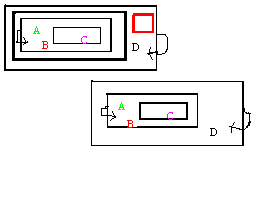
This model of temporal experience ties in very closely with the notion of helical time, which I have introduced in my discussion of the We have given a variation on the consciousness iteration which incorporates both a linear progression of time, that keeps on going from one step to the next to the next, and a circular motion of time, that keeps on returning to the same place over and over again. The intervals of linear progression -- of build-up of thick boxes, one after the other -- are forward-moving time. On the other hand, the elimination of these boxes and the return toward the ground state is backward-moving time. Time keeps going forward and backward, forwards and backwards, spiraling around the ineffable center, which is circular time -- the circular moment that gives up nothing, returning always precisely to itself.
Combs, Allan (1996). The Radiance of Being : Complexity, Chaos and the Evolution of Consciousness. New York: Paragon House.
Cramer-J-G. (1988). "An overview of the transactional interpretation of quantum mechanics", International Journal of Theoretical Physics. vol.27, no.2. pp. 227-36.
Goertzel, Ben (1994). Chaotic Logic: Language, Thought and Reality from the Perspective of Complex Systems Science. New York: Plenum Press.
Goertzel, Ben (1996). From Complexity to Creativity: Explorations in Evolutionary, Autopoietic Dynamics. New York: Plenum Press.
Ernest Hartmann (1993). Boundaries in the Mind : A New Psychology of Personality. New York: Basic Books.
Hawking, Stephen W. (1993). A Brief History of Time : From the Big Bang to Black Holes. New York: Bantam
McKenna, Terence and Dennis McKenna (1994). The Invisible Landscape : Mind, Hallucinogens, and the I Ching. New York: Harpercollins.
Prigogine, Ilya and Isabelle (1997). The End of Certainty : Time's Flow and the Laws of Nature. New York: Free Press
Smith, Tony (1997). Tony Smith's WWW Homepage. http://galaxy.cau.edu/tsmith/TShome.html
Spencer-Brown, G. (1994). Laws of Form. New York: Cognizer Co.